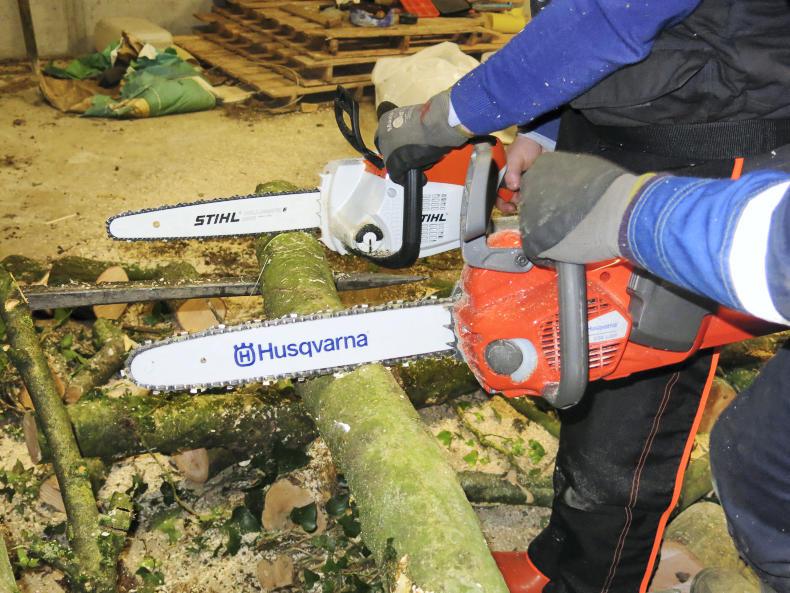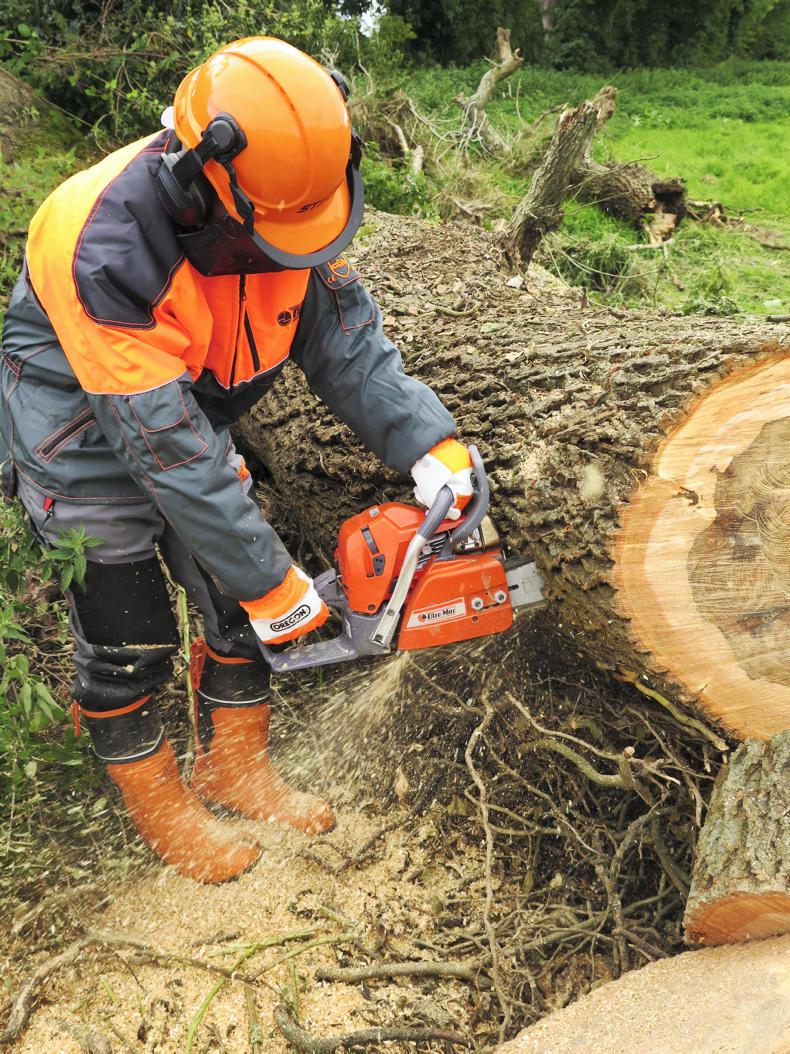A chainsaw was once described to Husqvarna sales manager Andy Walsh as “a fantastic servant but a terrible master”. This is evident when you see the amount of severe damage that chainsaws do to operators who do not use them correctly or to those who do not protect themselves adequately when cutting. In 35 years, Andy has seen all types of injuries. He said: “It makes no sense to me that someone would not provide themselves with all the protection that was available while using a tool that is revolving at approximately 21 metres per second.”
The basic personal protection that should be worn by a chainsaw operator is a helmet with visor and earmuffs. This is essential as the nature of trees is that they are normally over our heads and branches can fall and cause severe injuries. A visor will protect your eyes from flying debris and earmuffs are needed to protect your hearing as a chainsaw will produce as much noise pressure on your eardrums as some jet engines. A pair of chainsaw gloves with saw protection will resist the chain cutting your hands should they come in contact with a moving chain. You will need a pair of chainsaw trousers to protect your legs when cutting as they are the part of the body that are most at risk. It is essential that the trousers you buy give the protection against the type of saw you use. There are classes in protection to cope with various chain speeds that chainsaws operate at, known as 0, 1, 2 and 3.
Items which resist cutting at 16 m/s are classified as class 0, which is the typical level selected for hand protectors, gloves, upper body protectors and gaiters. It is generally the case that to obtain higher performance levels, for upper body protectors for example, so many layers of protective material are required that the garment becomes too uncomfortable for continuous wear. For leg protectors, the lowest allowable level of protection is class 1, which resists cutting at up to 20 metres per second chain speed. Protective products of class 2 or class 3 are tested at a chain speed of 24 metres per second and 28 metres per second respectively. All of the safety items are made of technically designed materials to provide the protection needed.
Tips for working the chainsaw
Always have your chainsaw fully maintained before usage – fully fuelled, lubricated with chain oil, with chain sharpened and correctly tightened. Ensure there are no fuel leaks or seepage and it will actually start.Make sure the chain brake works.Avoid using a chainsaw on your own. Even if fencing tell someone where you are going and when you expect to be back.Bring your phone and have it in an accessible pocket. Make sure it is fully charged. Check for coverage where you are working.Plan ahead and use the appropriate chainsaw PPE, even if it is for a small job.Bring an up-to-date first aid kit which includes eyewash and tweezers.Training
FRS runs two courses which cover all aspects of chainsaw use from maintenance, to basic use and appropriate PPE.
There are numerous chainsaw courses available from other firms and even free workshops on the basics of chainsaw maintenance and use. Prices are €80 for the one-day course with FRS certification and €150 for the QQI accredited, Level-5 chainsaw course.
For smartphone users, there are a number of first aid apps available for free download. Irish Red Cross is one and its app is very useful for all farming families.
Arthur Byrne of ESB Networks on electrical risks when using a chainsaw to cut trees
Never cut trees near overhead electricity wires because the wires may be touching the foliage or branches; either way there is a risk of receiving a fatal electric shock. There is no such thing as a perfect insulator and trees conduct electricity. That is why you will see trees scorched or burning when trees are tipping off the wires.
The other risk is felling a tree or lopping branches that can fall on to the wires, either causing the line to fall to the ground or remain in contact with the main part of the tree. Either way, there is a very serious risk of being electrocuted because the ground around the fallen wires or the tree will be “electrified”.
Remember to never handle or approach fallen wires. There are always ‘live’ and extremely dangerous. Always respect the power of electricity and keep your distance.

A chainsaw was once described to Husqvarna sales manager Andy Walsh as “a fantastic servant but a terrible master”. This is evident when you see the amount of severe damage that chainsaws do to operators who do not use them correctly or to those who do not protect themselves adequately when cutting. In 35 years, Andy has seen all types of injuries. He said: “It makes no sense to me that someone would not provide themselves with all the protection that was available while using a tool that is revolving at approximately 21 metres per second.”
The basic personal protection that should be worn by a chainsaw operator is a helmet with visor and earmuffs. This is essential as the nature of trees is that they are normally over our heads and branches can fall and cause severe injuries. A visor will protect your eyes from flying debris and earmuffs are needed to protect your hearing as a chainsaw will produce as much noise pressure on your eardrums as some jet engines. A pair of chainsaw gloves with saw protection will resist the chain cutting your hands should they come in contact with a moving chain. You will need a pair of chainsaw trousers to protect your legs when cutting as they are the part of the body that are most at risk. It is essential that the trousers you buy give the protection against the type of saw you use. There are classes in protection to cope with various chain speeds that chainsaws operate at, known as 0, 1, 2 and 3.
Items which resist cutting at 16 m/s are classified as class 0, which is the typical level selected for hand protectors, gloves, upper body protectors and gaiters. It is generally the case that to obtain higher performance levels, for upper body protectors for example, so many layers of protective material are required that the garment becomes too uncomfortable for continuous wear. For leg protectors, the lowest allowable level of protection is class 1, which resists cutting at up to 20 metres per second chain speed. Protective products of class 2 or class 3 are tested at a chain speed of 24 metres per second and 28 metres per second respectively. All of the safety items are made of technically designed materials to provide the protection needed.
Tips for working the chainsaw
Always have your chainsaw fully maintained before usage – fully fuelled, lubricated with chain oil, with chain sharpened and correctly tightened. Ensure there are no fuel leaks or seepage and it will actually start.Make sure the chain brake works.Avoid using a chainsaw on your own. Even if fencing tell someone where you are going and when you expect to be back.Bring your phone and have it in an accessible pocket. Make sure it is fully charged. Check for coverage where you are working.Plan ahead and use the appropriate chainsaw PPE, even if it is for a small job.Bring an up-to-date first aid kit which includes eyewash and tweezers.Training
FRS runs two courses which cover all aspects of chainsaw use from maintenance, to basic use and appropriate PPE.
There are numerous chainsaw courses available from other firms and even free workshops on the basics of chainsaw maintenance and use. Prices are €80 for the one-day course with FRS certification and €150 for the QQI accredited, Level-5 chainsaw course.
For smartphone users, there are a number of first aid apps available for free download. Irish Red Cross is one and its app is very useful for all farming families.
Arthur Byrne of ESB Networks on electrical risks when using a chainsaw to cut trees
Never cut trees near overhead electricity wires because the wires may be touching the foliage or branches; either way there is a risk of receiving a fatal electric shock. There is no such thing as a perfect insulator and trees conduct electricity. That is why you will see trees scorched or burning when trees are tipping off the wires.
The other risk is felling a tree or lopping branches that can fall on to the wires, either causing the line to fall to the ground or remain in contact with the main part of the tree. Either way, there is a very serious risk of being electrocuted because the ground around the fallen wires or the tree will be “electrified”.
Remember to never handle or approach fallen wires. There are always ‘live’ and extremely dangerous. Always respect the power of electricity and keep your distance.







 This is a subscriber-only article
This is a subscriber-only article












SHARING OPTIONS: